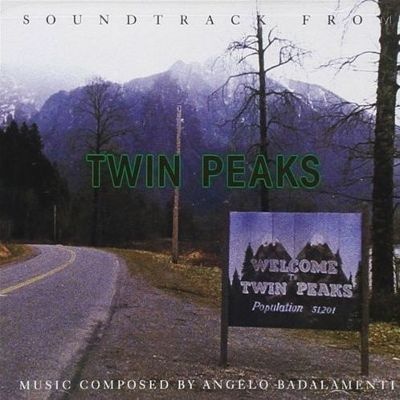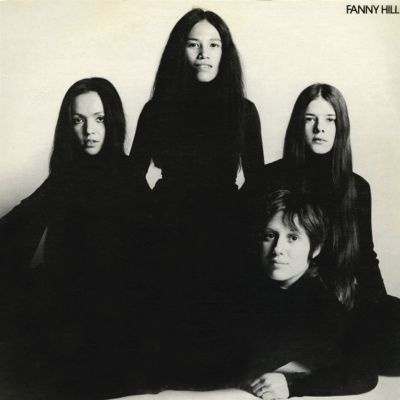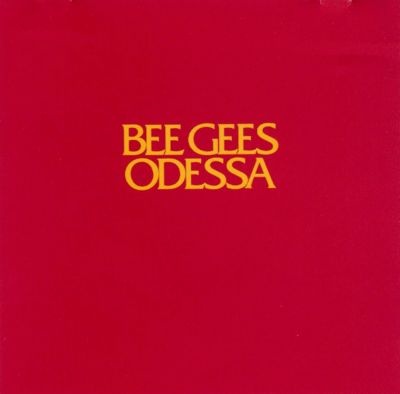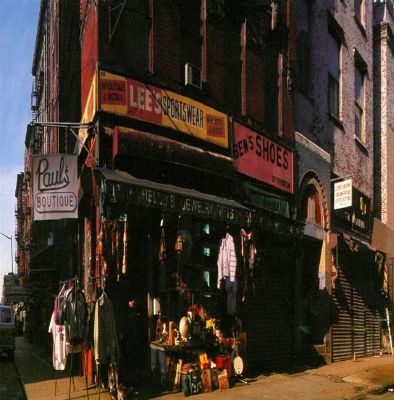Kicking yourself. That’s usually the feeling. When you finally sit down with an album that changes your life, you think “Why wasn’t I listening to this the whole time?”
So many wasted hours of not hearing the harmonies of early-era Bee Gees, or the otherworldly inventive sounds of Os Mutantes, or the genre-defining sampledelic grooves of the Beastie Boys. Sometimes it isn’t your fault… born to late, or the record never flew into to your radar, but sometimes it’s your own stubbornness that keeps you from digging into a record that becomes a soundtrack to your life.
We at AllMusic embrace these late discoveries and proudly (and in some cases abashedly) present some of our personal “late to the party” albums. Don’t let them pass you by.
Spring Session M by Missing Persons
By the time I discovered this album in my mom’s record collection, four decades had passed since it was released in 1982. If it had been part of my musical upbringing alongside the Eurythmics and Duran Duran, it might have become a core sonic memory, celebrated as one of my all-time-faves, instead of being a late-in-life discovery that still gets spun regularly.
Influencing a crop of artists that I naturally gravitated to over the years (our AllMusic review rightly points to No Doubt, theStart, and The Sounds), Spring Session M is an addictive gem, incorporating synthpop, rock, and punk. If you’re not familiar with the album, “Destination Unknown,” “Walking In L.A.,” and “Words” are the big ones that you may have heard in passing without knowing. There’s countless albums that I found way past their prime, but in recent years, this is the one that landed in my collection and hasn’t left rotation since. – Neil Z. Yeung
 Twin Peaks by Angelo Badalamenti
Twin Peaks by Angelo Badalamenti
I was already a big fan of David Lynch by the time Twin Peaks launched — so much so that when I missed the original run of the series because I was in college (studying film and “Western art music”), I avoided any possible form of spoiler, including the soundtrack, until I could have my moment. Then there were media format changes, major life events, blah, blah, blah, fast-forward to the COVID-19 pandemic.
After being out of the loop for so long, I finally watched the whole franchise, and boy oh boy do I wish it hadn’t taken me 30 years. I had certainly heard the theme music and some select songs from the show over the years, and I even ended up reviewing an artist or two from the Roadhouse in the 2010s, but I hadn’t sat down with that beautiful, influential, sad, strange, whimsical, longing original soundtrack. Now fully traumatized by the series, I can listen to it on CD at home in my new “Fix your hearts or die” hoodie, as anachronistic as Badalamenti and Lynch’s vision for the music. – Marcy Donelson
 Os Mutantes by Os Mutantes
Os Mutantes by Os Mutantes
For decades, I knew about Os Mutantes as a major hipster favorite, namechecked by Kurt Cobain as an influence and a staple of record stores like NYC’s Other Music (R.I.P.) that I used to frequent. My college radio station had burned CD-Rs of their first few records, and the compilation Luaka Bop released, and I just never bothered to give them a listen for whatever reason. Flash forward to 2020, and I spent nearly the entire year stuck in my room listening to music because of the COVID-19 lockdown, so I started a summer listening project and caught up on tons of classic albums and DJ mixes that I hadn’t heard before, or heard so long ago that I barely remembered them.
This led me to finally hear things like Eric Dolphy‘s Out to Lunch and Company Flow‘s Funcrusher Plus which fully lived up to their classic status. But nothing else made me feel mad at my earlier self for ignoring than the first Os Mutantes record. This easily would have been up there with White Noise‘s An Electric Storm and the self-titled album by The United States of America as one of my favorite mind-blowing ’60s records if I’d gotten into it around the same time. So this led me down the rabbit hole to finally get into and appreciate other classic Tropicalia and MPB records by Gal Costa, Gilberto Gil, Milton Nascimento & Lô Borges, and others. – Paul Simpson
 Together Alone by Crowded House
Together Alone by Crowded House
As a reissue and box set enthusiast, most of my music collecting is centered on albums of the past added to my present, and so there are many great works I wish passed my way sooner. One such example is Together Alone, the fourth album by Antipodean pop icons Crowded House.
Coming seven years after radio staple “Don’t Dream It’s Over” and prefacing a mid-’90s hiatus that would last a decade, Together has all the qualities that makes Neil Finn my favorite living songwriter. Tunes like “Private Universe,” “Distant Sun” and “In My Command” are full of Finn’s typical melodic gifts – sticky and sweet like honey – along with that ongoing mystery and faith in the unknowable quantities of life that power his greatest lyrics (“I don’t pretend to know what you want / but I offer love”). Crowded House, like all my favorites, came to me at the right time (after an old roommate slid a best-of into my hands on a record shopping trip) – but like all prized possessions, you might wish you had them even longer than you do. – Mike Duquette
 Saturday Night Special by The Lyman Woodard Organization
Saturday Night Special by The Lyman Woodard Organization
Getting interested in jazz through the entry point of chaotic improvisation from Ornette Coleman and Albert Ayler didn’t leave a lot of room for subtlety. The excitement of free jazz burned brightly for me for many years before I started noticing the intricacies in less outraged and outrageous sounds from all types of jazz figures, eventually being captivated by Pharoah Sanders‘ meditative bliss, Wayne Shorter‘s transportative solo journeys, and this collection of amazing homegrown grooves from Detroit-based organist Lyman Woodard.
Released in 1975 on the Strata label, Saturday Night Special captures in sound the images of lonely Detroit streets that once bustled, late-night drives, and bright summer days at the open air market. The slightly lo-fi production is an essential part of the sound, never dulling the vibrancy, but adding to the timeless feel of this album. I wasn’t ready for this level of quietly expressive joy when I was blasting impenetrable large group free jazz freakouts, but I wish I’d heard it years before I did, if only to experience the melancholic otherworldliness of “Joy Road” when I was more impressionable. – Fred Thomas
 Fanny Hill by Fanny
Fanny Hill by Fanny
I feel like I probably have a lot of compatriots in this selection, since it seems like until just recently the whole world forgot about Fanny, “the first all-female rock band” (a dubious claim that made for great marketing copy). All of their albums are terrific fun, but their third release is where they really solidified, both in songwriting and in playing.
Produced at Abbey Road with Geoff Emerick engineering, the best songs are bottom-heavy and rollicking, including the barn-burner “Blind Alley” and a cover of Marvin Gaye‘s “Ain’t That Peculiar” assisted by longtime Rolling Stones sax player Bobby Keys. A great starting point is their performance of “Hey Bulldog” which stomps and sneers even harder than the original. – Zac Johnson
 Odessa by Bee Gees
Odessa by Bee Gees
In 2004, I released my very earnest debut solo album which was heavily inspired by the lush pop arrangements of Brian Wilson, the Zombies, and the Left Banke. I was in my mid-20s and worked part-time at a hip record store — I thought I knew most of the landmark ’60s chamber pop albums. A reviewer from a now-defunct Detroit weekly rag suggested that my album owed a great debt to the Bee Gees‘ Odessa.
When I read this, I was a little embarrassed that I’d never even heard the Gibbs’ 1969 opus. I promptly bought the newly-reissued CD (in a red velvet clamshell box, of course) and had my mind blown. The Bee Gees, as presented to me in my youth, were the hairy-chested polyester knights of the discotheque who sang “Stayin’ Alive” and “Jive Talkin’.” They were frozen in the amber of the era that made them famous. I knew they’d originally come up in the ’60s, but had never bothered to investigate their origin story. As I worked backwards from Odessa, I learned the truth — the Bee Gees were genius pop chameleons, perhaps a bit too earnest (like myself), but capable of brilliance. Those early records are now some of my favorites, but Odessa is the pillar of their ’60s ambitions. – Timothy Monger
 Paul’s Boutique by Beastie Boys
Paul’s Boutique by Beastie Boys
I have a horrible confession to make – I hated the first Beastie Boys album, 1986’s Licensed To Ill, when it first came out. Really hated it. Even said so for posterity in a fanzine you thankfully never read. (Note to readers: I’m an old man.)
I thought the production was pretty great, but three privileged white kids pretending to be B-Boys, spouting rhymes that dripped with misogyny? It seriously rubbed me the wrong way, even though I knew they were kinda sorta joking. It wasn’t until the Beasties grew up a bit in the mid-1990s that I started giving them a re-appraisal and realized they had more and better things to say, and had become significantly more capable as musicians and lyricists. But the minor tragedy in this story is I never really sat down and listened to 1989’s Paul’s Boutique until about twenty-five years after it came out, when I found a CD copy for a buck at a library sale.
Holy crap, did I miss the boat on that. The rhymes are fine, strong, fun, and a lot more conscious than before, and the Dust Brothers‘ sampledelic production is a thing of wonder, layers upon layers of dazzling ingredients that makes one nostalgic for the wild and wooly days when DJs and producers were searching the world for cool sounds to sample, before the lawyers came in and spoiled the fun. And I’m sure most of you already know that. For years, folks kept telling me Paul’s Boutique was a masterpiece and I just nodded and said, yeah, sure, I’ll sit down with it one of these days.
Turns out every last one of them was right, and I’ve come to love it. It’s just like how I hated R.E.M.‘s Automatic For The People in 1992 because I wanted lots more upbeat jangle, and took about ten years to truly appreciate its gentle beauty. The moral of this story is, when it comes to music, it’s a good thing to be willing to acknowledge you can be wrong, and if people you trust tell you to give an album another chance, give it a try. I still don’t get Madonna, though. – Mark Deming
Ok, that’s us. What albums have you stumbled into that made their way into regular rotation much later than they should have? Let us know.



